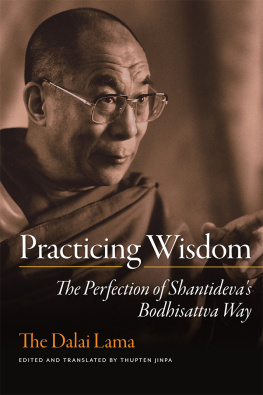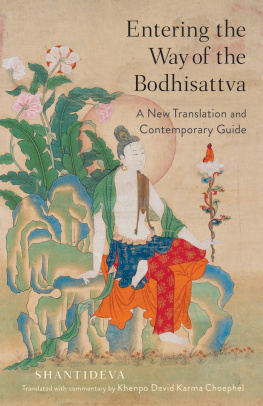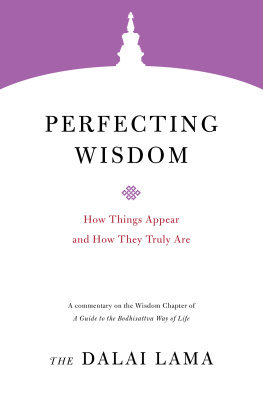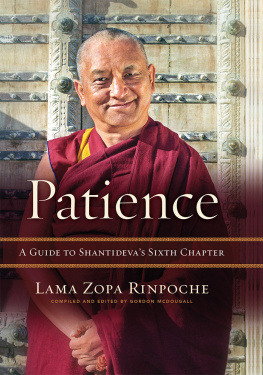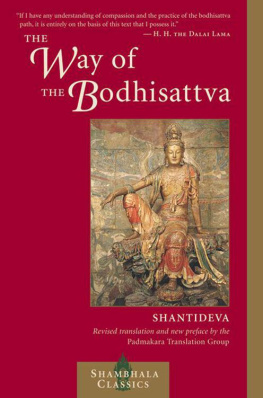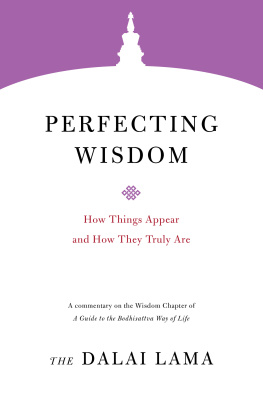PRACTICING WISDOM

Wisdom Publications
199 Elm Street
Somerville, MA 02144 USA
wisdompubs.org
2005 Tenzin Gyatso, the Fourteenth Dalai Lama, and Thupten Jinpa
All rights reserved.
No part of this book may be reproduced in any form or by any means, electronic or mechanical, including photography, recording, or by any information storage or retrieval system or technologies now known or later developed, without permission in writing from the publisher.
Library of Congress Cataloging-in-Publication Data
Bstan-'dzin-rgya-mtsho, Dalai Lama XIV, 1935
Practicing wisdom : the perfection of Shantidevas Bodhisattva way / Dalai Lama; translated and edited by Thupten Jinpa.
p. cm.
Includes bibliographical references and index.
ISBN 0-86171-182-3 (pbk. : alk. paper)
1. Sntideva, 7th cent. Bodhicaryvatra 2. Mahayana BuddhismDoctrines. I. Title: Perfection of Shantideva's Bodhisattva way. II. Thupten Jinpa. III. Title.
BQ3147.B777 2004
294.3'85DC22
2004021413
ISBN 978-0-86171-182-6 ebookISBN 978-0-86171-748-4
19 18 17 16 15
6 5 4 3 2
Cover based on a design by Gopa&Ted2, Inc. Cover photo by Merrick Morton.
Interior design by DcDesign. Set in Granjon 12/14.5 pt.
The translation of the verses from Shantidevas Bodhicharyavatara is adapted with kind permission from The Way of the Bodhisattva, translated by the Padmakara Translation Group (Boston: Shambhala Publications, 1997).
Wisdom Publications books are printed on acid-free paper and meet the guidelines for permanence and durability of the Committee on Production Guidelines for Book Longevity of the Council on Library Resources.
This book was produced with environmental mindfulness. We have elected to print this title on 30% PCW recycled paper. As a result, we have saved the following resources: 3 trees, 2 million BTUs of energy, 200 lbs. of greenhouse gases, 1,087 gallons of water, and 73 lbs. of solid waste. For more information, please visit our website, wisdompubs.org.
Printed in United States of America.

Please visit fscus.org.
Publishers Acknowledgment
The publisher gratefully acknowledges the kind help of Richard Gere in sponsoring the publication of this book.
The ninth chapter of Shantidevas The Way of the Bodhisattva, which is the basis of His Holiness the Dalai Lamas teachings presented here in this volume, begins with the statement that it is for the sake of cultivating wisdom that the Buddha taught all the various aspects of the teachings. This seemingly simple assertion captures a profound insight that lies at the heart of Buddhas spiritual message. Unlike many of his spiritual peers, the Buddha argued that it is not through ascetic physical penance, through complicated religious rituals, nor through prayers that one attains highest spiritual awakening. It is through the disciplined taming of ones mind. Furthermore, since our bondage to a perpetual cycle of unenlightened existence is rooted in a fundamental ignorance of the very nature of our own existence, the cultivation of a deep understanding of the nature of our existence must constitute a central element of this spiritual discipline. Hence the emphasis on the cultivation of wisdom.
It is no exaggeration to assert that Shantidevas The Way of the Bodhisattva (Bodhicharyavatara) is one of the most important spiritual and philosophical texts of Mahayana Buddhism. Written in the eighth century C.E., this short work of just under a thousand stanzas soon became a classic on the topic of a bodhisattvas long journey to the full awakening of buddhahood. In contrast to Compendium of the Perfections, another classical Mahayana Buddhist work similarly written in verse and Shantidevas text is not explicitly structured according to the well-known Mahayana framework of the six perfections. Although there are chapters (chapters 59) dedicated to each of the last four of the perfectionsforbearance, joyous effort, meditation, and wisdomthe first four chapters deal with various aspects of the endeavor of generating the awakening mind (bodhichitta), while the final chapter (chapter 10) presents a series of deeply moving altruistic aspirations of the bodhisattva.
Shantidevas classic was first translated into Tibetan in the ninth century from a Kashmiri redaction. It was later revised by Lotsawa Rinchen Sangpo on the basis of a careful comparison with a central Indian edition of the root text and related commentaries; it was once again critically revised in the twelfth century by the famous Tibetan translator Ngok Loden Sherap. Thanks primarily to the early teachers of the Tibetan Kadam tradition, including its founding fathersthe Indian Bengali master Atisha and his principal student Dromtnpa, who regularly cited poignant stanzas from Shantidevas classic in their own teachingsThe Way of the Bodhisattva came to enjoy tremendous popularity within Tibetan Buddhist circles. Alongside Nagarjunas Precious Garland Shantidevas text became a root text for the Tibetan tradition of lojong, mind training, where the central objective is the cardinally important spiritual endeavor of cultivating the awakening mindthe altruistic aspiration to attain buddhahood for the benefit of all beingsand enacting this altruistic principle in day-to-day life. The next eight to nine hundred years saw a tremendous increase in both the popularity and influence of this short work in all the major lineages of Tibetan Buddhism, attracting substantive commentaries from such great Tibetan teachers as the Sakya hierarch Snam Tsemo, the lojong master Nglchu Thokme Sangpo, the great Geluk author Gyaltsap Je, the Kagy teacher and noted historian Pawo Tsuklak Trengwa, as well as the well-known Nyingma master Dza Paltrl.
The influence of this Buddhist text on the thought of the present Dalai Lama is unmistakable. Not only does he cite most liberally from it during his numerous public discourses on Buddhism, even in his engagement with the wider non-Buddhist audience the Dalai Lama shares his enthusiasm for Shantidevas The Way of the Bodhisattva. In fact, he cites the following stanza from Shantideva as his greatest source of spiritual inspiration and strength.
For as long as space remains,
For as long as sentient beings remain,
Until then, may I too remain
And dispel the miseries of the world.
Perhaps part of the reason for the great popularity of this classical Indian Buddhist work in Tibet lies in the beauty of its poetry. Most of the time the author writes in the first-person voice, with the elements of the various practices of the aspiring bodhisattva as a series of personal reflections. Many of his lines convey a powerful sense of immediacy, and their poignancy for a spiritual aspirant remains starkly evident.
Like many young Tibetan monks, I had the privilege of memorizing the text in my early teens and thus had the honor to recite the entire work from heart many times, often in the comparatively cool nights of southern India where my monastery was based. To this day, I can fondly recall the joy with which I went through the process of memorizing this text while working in the corn fields of the Tibetan resettlement camp to which my small monastery belonged in the 1970s. In the Tibetan edition, the stanzas are written in perfectly metered verse with a language that can rival any original Tibetan poetic work, easily lending itself to memorization and recitation.
Next page
